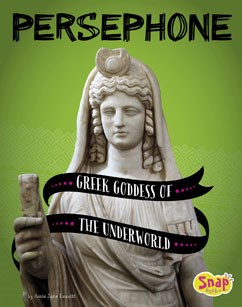Title of the work
Country of the First Edition
Country/countries of popularity
Original Language
First Edition Date
First Edition Details
Amie Jane Leavitt, Persephone, Greek Goddess of the Underworld, "Legendary Goddesses". North Mankato: Snap Books (Capstone Press), 2019, 32 pp.
ISBN
Genre
Myths
Target Audience
Children (young readers, 6–8 year olds)
Cover

Cover courtesy of Capstone publishing.
Author of the Entry:
Ayelet Peer, Bar-Ilan University, ayelet.peer@biu.ac.il
Peer-reviewer of the Entry:
Lisa Maurice, Bar-Ilan University, Lisa.maurice@biu.ac.il
Elizabeth Hale, University of New England, ehale@une.edu.au

Amie Jane Leavitt (Author)
Amie Jane Leavitt is an author and a writer. She writes material for various fields, such as travel, education, health and more. She has written nearly 100 books for children and young adults. Amie Jane Leavitt was a student at Brigham Young University majoring in education. She was also a teacher at a private school for at-risk youth.
Source:
Official website (accessed: August 19, 2020).
Bio prepared by Ayelet Peer, Bar-Ilan University, ayelet.peer@biu.ac.il

Susan C. Shelmerdine
Content Consultant.
Susan C. Shelmerdine is a professor of Classical Studies at the University of North Carolina., Greensboro. She received her Ph.D. University of Michigan in 1981. She researches Greek and Latin pedagogy and in early Greek poetry.
Bio prepared by Ayelet Peer, Bar-Ilan University, ayelet.peer@biu.ac.il
Summary
This book is part of a Legendary Goddesses by Capstone publishing, a set of short informational books on ancient goddesses, which includes books on Aphrodite, Athena, Hera, Diana, Freya, Hathor and Isis (about the series see here).
The book contains glossaries for numerous words (for example, chariot, cypress, pantheon etc.), both within the individual chapters and also at the end of the book. The chapters narrate the following: the abduction of Persephone, the relation between her abduction and the seasons, the Olympian Pantheon, Persephone’s lineage and family tree (parents and half-siblings), her offspring, her dual personality and appearance as goddess of spring as well as the underworld, her responsibilities, her cults, her Roman name, the modern Hellenismos religion, and Persephone in modern popular culture. There are also brief facts on the symbolism of the pomegranate and how natural events were explained in other cultures (Chinese, Native American, South American). At the end of the book there is a short further reading section and an index.
Analysis
This book is a part of a series of informational texts that use a mixture of storytelling, and archival images to present the goddess Persephone. The book aims to provide clear and readable information about Persephone, but specifically adapted for young readers; and thus the myths have been altered accordingly. One example of such adaptation is the story of Persephone’s abduction. While it is narrated that Hades requested Zeus’ permission to carry off and wed his daughter, it is later mentioned that, “Persephone had fallen in love with Hades after she had eaten some of Hades’ pomegranate seeds.” (p. 9). The pomegranate seeds here act as a love potion and not just as the tool through which Persephone is bound to Hades. There is no mention either of any trickery by Hades relating to the seeds. As Elizabeth Hale adds, “many contemporary women writers especially revise the story like this to emphasize Persephone’s agency.” (Hale, peer-review) While Hades explains to Zeus that she cannot return since she dined in the underworld, the falling in love part was probably added to reassure the young readers of Persephone’s fate, that she was not held against her will. It is once more affirmed that she approved of Zeus’ decision to let her stay one part of the year in the underworld and the rest on earth since “she did love Hades. But she loved her mother too.” (p.10). However, making Persephone love Hades due to the pomegranate seeds can be interpreted as moderately keeping with the original tale of Hades’ mischief and violence. Persephone does not truly love him but she cannot leave him now.
Pseudo-Apollodorus, Bibliotheca 1. 29 tells how Hades gave Persephone the seeds, of which significance she was unaware. In the Homeric Hymn to Demeter Hades also gives her the seeds in secret.
Another adaptation appears in the description of Demeter’s duty. She and Persephone helped the farmers with their crops in order to have a productive harvest “otherwise they would have little to sacrifice to the Olympic pantheon. Small sacrifices always angered Zeus and the other gods.” (p. 6). Demeter and Persephone help in maintaining the peace between earth and Olympus. While we know of Zeus’ attitude towards sacrifice mainly from the myth of Prometheus, the sacrifice mentioned is usually one of meat and not of harvest. Hence Demeter’s duty is slightly reduced here, perhaps in order not to overshadow Persephone, the book’s main heroine.
The book also compares Greek mythology briefly with other cultures, regarding the explanation of natural events. The Native Americans, Chinese and South American beliefs are concisely noted. Therefore this passage creates a link between ancient cultures and how different societies and cultures shared similar traits.
There is a short passage on Persephone’ appearance in pop culture. Amazonian warrior in the 2009 Wonder Woman film, a character (Perse) in Stephen King’s Duma Key book, video games such as Skylanders.
The author explains to the young readers the intricate relations in the Greek pantheon, a theme which appears again in the books on Athena and Diana, with different explanations. She explains that inter-family marriages “according to the myths, allowed the deities to pass on their special superhuman powers to their offspring” (p. 19). While the ancient myths do not explain why the gods married each other, this explanation is logical and can be better understood by young readers. Hence the author does not avoid the difficult issue of brother-sister marriages (or father-daughter) but explains it in “super-heroes” logic.


